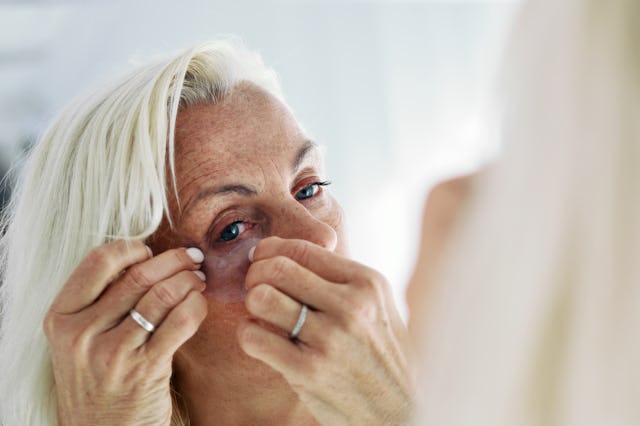Do Wrinkle Patches Really Work? A Dermatologist Explains Whether They’re Worth The Money
If you like using them, great. If you don’t want to sleep with papier mache on your face, that’s fine too.

We’ve all seen the very Mommy Dearest-coded morning shed videos on TikTok: You know, where someone shuffles into a bathroom first thing in the morning and starts removing all the face tape, hair curlers, and sheet masks they slept in, emerging like a weird gooey larva with a perfect blowout. The morning shed is a new trend, but one part of them — wrinkle prevention patches — date back to the late 1800s. So, do wrinkle patches work? We asked a dermatologist if it’s worth the time and money to layer on the patches before bed each night.
Do wrinkle patches work?
Some brands of wrinkle patches, like Frownies, are made of kraft paper and a water-activated adhesive. You just cut them to fit your face, wet to apply, and then wait for them to dry down. Many other brands sell silicone patches. Do any of them really get rid of old wrinkles or prevent new ones?
"In the short term, yes, facial patches can temporarily smooth fine lines by keeping skin still and locking in moisture. They may help prevent deepening wrinkles if used consistently, but they won't erase them or replace proven treatments like SPF, retinoids, or in-office procedures," says dermatologist Dr. Dara Spearman.
Spearman emphasizes that if you like wearing wrinkle patches to bed, do you! They just aren't going to change your skin long-term. "Just keep in mind these tools are fine as part of a self-care routine, but don't expect lasting results. And if you are uncomfortable and cannot sleep with all these treatments on your face, don't stress because, at the end of the day, they show temporary results. You are better off prioritizing your sleep. Stick with science-backed skincare and talk to a dermatologist for real, lasting change," she says.
Do wrinkles really form while you sleep?
It makes sense why people turn to wrinkle patches to prevent new lines from forming overnight. Sometimes the way we sleep does, in fact, contribute to wrinkle formation. That said, the best way to prevent wrinkles in your sleep is totally free.
“Repeated pressure on your face from sleeping on your side or stomach can lead to sleep lines, which are wrinkles caused by mechanical compression over time. These are different from sun or age-related wrinkles and tend to show up on the cheeks, forehead, and chest,” Spearman says. “While tools like wrinkle patches and special pillows can help minimize this pressure, the most effective prevention is sleeping on your back and using smooth fabrics, like silk pillowcases. Similar to the morning shed, these methods can support skin health, but lasting results still come from consistent skincare, sun protection, and professional treatments.”
How to actually prevent wrinkles, according to a dermatologist
When it comes to preventing and reducing wrinkles, the most effective, science-backed strategies focus on protecting collagen and encouraging skin renewal, Spearman explains. She recommends:
- Focusing on your wellness, like staying hydrated, getting enough sleep, and avoiding smoking
- Using a broad-spectrum sunscreen (SPF 30 or higher) every day
- Applying topical retinoids, like retinol or prescription tretinoin
- Adding antioxidants into your skincare, like vitamin C, to help protect against environmental damage
- Opting for a moisturizer that has peptides and hyaluronic acid
- Asking your doctor about treatments to reduce the appearance of deep wrinkles and texture — think chemical peels, lasers, microneedling, or Botox
Lastly, remember that doing the absolute most to your skin is not necessarily the answer. “More isn’t always better,” Spearman says. “Over-exfoliating, layering too many products, or trying every trending trend can actually cause inflammation or irritation. A balanced, consistent routine tailored to your skin is better than chasing every new trend.”